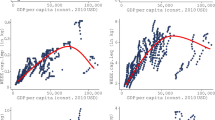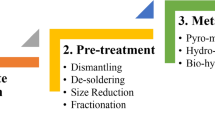Abstract
Until now, only rough estimates were available for the number of televisions (TVs) added to the growing stockpile of obsolete TVs by the June 2009 federally mandated digital transition. This event caused millions of Americans either to replace functioning analog TVs with digital units and purchase cable or satellite service, or to purchase subsidized analog-to-digital converter boxes. In this context, this paper makes two contributions based on results of a survey of 3,156 U.S. households conducted between the end of December 2009 and January 2010. First, we estimate the number of analog TVs that were retired as a result of the digital transition and we analyze the socioeconomic characteristics of the households affected. Second, we quantify the volume of nine metals (antimony, cadmium, chromium, copper, gold, lead, palladium, silver, and zinc) contained in these retired TVs. Our results are important to understand the e-waste consequences of the digital transition and to inform U.S. e-waste policy.
Similar content being viewed by others
References
FCC, The Digital TV Transition—What You Need to Know about DTV (Washington, D.C.: Federal Communication Commission, 2009), retrieved 02/01/11 from www.dtv.gov/consumercorner.html.
U.S. EPA, “Electronics Waste Management in the United States: Approach One” (No. 530-R-07-004a) (Washington, D.C.: U.S. Environmental Protection Agency, 2008).
B.H. Robinson, “E-waste: An Assessment of Global Production and Environmental Impacts,” Science of the Total Environment, 408 (2009), pp. 183–191.
U.S. EPA, “Lead in Paint, Dust, and Soil” (Washington, D.C.: U.S. Environmental Protection Agency, 2010), retrieved 12/21/10 from www.epa.gov/lead/pubs/leadinfo.htm.
U.S. EPA, “Cadmium Compounds” (Washington, D.C.: U.S. Environmental Protection Agency, 2007), retrieved on 12/21/10 from www.epa.gov/ttnatw01/hlthef/cadmium.html.
U.S. EPA, “Chromium Compounds” (Washington, D.C.: U.S. Environmental Protection Agency, 2007), retrieved on 12/21/10 from www.epa.gov/ttnatw01/ hlthef/cadmium.html.
UNEP, “Recycling—From E-Waste to Resources” (United Nations Environmental Program, 2009), retrieved on 11/13/10 from www.unep.org/PDF/PressReleases/E-Waste_publication_screen_FINALVERSION-sml.pdf.
T. Matsuto, C.H. Jung, and N. Tanaka, Waste Management, 24(5) (2004), pp. 425–436.
UNU, “Review of Directive 2002/96 on Waste Electrical and Electronic Equipment (WEEE): Final Report” (Bonn, Germany: United Nations University, 2008).
ATSDR, “2007 CERCLA Priority List of Hazardous Substances” (Atlanta, Georgia: Agency for Toxic Substances & Disease Registry, 2007), retrieved on 04/26/11 from www.atsdr.cdc.gov/cercla/07list.html.
U.S. Census Bureau, “American Community Survey Demographic and Housing Estimates: 2009” (Washington, D.C.: U.S. Census Bureau, 2010), retrieved 02/28/11 from www.factfi nder.census.gov.
J.S. Long and J. Freese, Regression Models for Categorical Dependent Variables using Stata, 2nd edition (College Station, TX.: Stata Press, 2006).
Author information
Authors and Affiliations
Corresponding author
Rights and permissions
About this article
Cite this article
Saphores, JD., Milovantseva, N. E-waste and the digital transition: Results from a survey of U.S. Households. JOM 63, 14–17 (2011). https://doi.org/10.1007/s11837-011-0148-5
Published:
Issue Date:
DOI: https://doi.org/10.1007/s11837-011-0148-5




